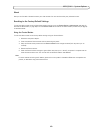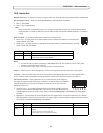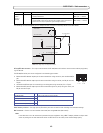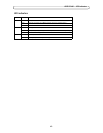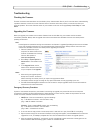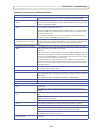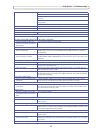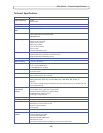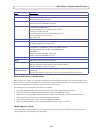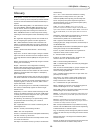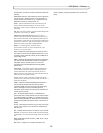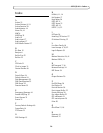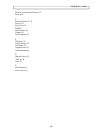
52
AXIS Q7401 - Glossary
Glossary
Active Speaker - a speaker with a built-in power amplifier.
ActiveX - A control (or set of rules) used by a browser. ActiveX
controls are often downloaded and installed automatically as
required.
Advanced Audio Coding (AAC) - is an audio codec that is at the
core of the MPEG-4, 3GPP and 3GPP2 specifications, and is
used for Internet, wireless and digital broadcast audio. AAC
combines high quality audio encoding with a small file size.
AMC - AXIS Media Control. The control required for viewing
video images in Internet Explorer. Installs automatically on first
use.
API - Application Programming Interface. The Axis API can be
used for integrating Axis products into other applications.
ARP - Address Resolution Protocol. Used to associate an IP
address to a hardware MAC address. A request is broadcast on
the local network to find out what the MAC address is for the
IP address.
ARTPEC - Axis Real Time Picture Encoder - used for image
compression.
Aspect ratio - A ratio of width to height in images. A common
aspect ratio used for television screens and computer monitors
is 4:3. High-definition television (HDTV) uses an aspect ratio of
9:16.
BOOTP - A protocol that can automatically configure a network
device (give it an IP address).
Bonjour - Also known as zero-configuration networking,
Bonjour enables automatic discovery of computers, devices, and
services on IP networks. Bonjour allows devices to
automatically discover each other without the need to enter IP
addresses or configure DNS servers. Bonjour is developed by
Apple Computer Inc.
CGI - Common Gateway Interface. A set of rules (or a program)
that allows a Web Server to communicate with other programs.
Client/Server - Describes the network relationship between two
computer programs, in which one, the client, makes a service
request from another - the server.
DC-Iris - This special type of iris is electrically controlled by the
Axis camera, to automatically regulate the amount of light
allowed to enter.
dB (Decibels) - A unit to measure sound level changes. A 3dB
change is the smallest level change we can hear. A 3dB change
is actually twice or half the audio power level. A gain of 0dB
will leave the signal level unchanged.
De-interlacing - De-interlacing is the process taking a stream
of interlaced frames and converting it to a stream of
progressive frames.
DSL - Digital Subscriber Line. A means of transferring data via
standard phone lines.
Ethernet - A widely used networking standard.
ETRAX - Axis' own microprocessor.
Firewall - A virtual barrier between a LAN (Local Area Network)
and other networks, e.g. the Internet.
FTP - File Transfer Protocol. Used for the simple transfer of files
to and from an FTP-server.
Full-duplex - Transmission of data, e.g. audio, in two directions
simultaneously.
G.711 - G.711 is the international standard for encoding
telephone audio on 64 kbps channel. It is a pulse code
modulation (PCM) scheme operating at 8 kHz sample rate.
G.726 - Frequently used speech-compression algorithm in
telecommunications due to its high perceived speech quality
and low resource requirements.
H.264 - Also known as MPEG-4 Part 10. This is the new
generation compression standard for digital video. H.264 offers
higher video resolution than Motion JPEG or MPEG-4 at the same
bit rate and bandwidth, or the same quality video at a lower bit
rate.
Half-duplex- A half-duplex link communicates in one direction
at a time only, much like a walkie-talkie. Two way
communication is possible, but not simultaneously.
HTTP - Hypertext Transfer Protocol. The set of rules for
exchanging files (text, images, sound, video, and other files) on
the World Wide Web.
HTTP-S (HTTPS)- An extension to the HTTP protocol to support
sending data securely over the World Wide Web.
Intranet -
A private network limited to an organization or
corporation. Usually closed to external traffic.
IP - Internet Protocol. See TCP/IP.
IP address - A unique number used by a computer on the
network to allow it to be identified and found.
ISMA - Internet Streaming Media Alliance.
JPEG - A standard image format, used widely for photographs.
Also known as JPG.
LAN - A local area network (LAN) is a group of computers and
associated devices that typically share common resources
within a limited geographical area.
Linux - A popular operating system that is “open source” and
practically free of charge.
Local storage - If a camera or video encoder supports local
storage, an SD card can be inserted into the SD card slot to
locally record and store a video stream.
Lux - A standard unit for light measurement.
Mbit/s - Megabits per second. A unit for measuring speeds in
networks. A LAN might run at 10 or 100 Mbit/s.
Motion JPEG - Delivers a high quality video stream, from which
individual images can be extracted and saved.
MPEG-4 - A video compression standard that makes good use of
bandwidth, and which can provide DVD-quality video streams at
less than 1 Mbit/s.
Multicast - A bandwidth-conserving technology that reduces
bandwidth usage by simultaneously delivering a single stream of
information to multiple network recipients.
PEM - Privacy Enhanced Mail. An early standard for securing
electronic mail. The PEM-format is often used for representing
an HTTPS certificate or certificate request.
Ping - A small utility used for sending data packets to network
resources to check that they are working and that the network
is intact.
Pre/post alarm image - The images from immediately before
and after an alarm.
Protocol - A special set of rules governing how two entities will
communicate. Protocols are found at many levels of



